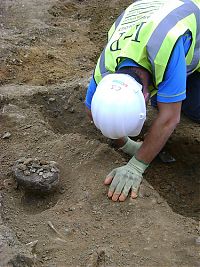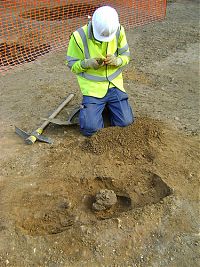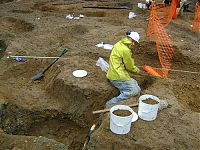The Donut Method
- By: Ceri Shipton |
- Sep 09, 2008
- Share
- del.icio.us

After excavating a soak-away, two quarry pits and a linear feature I found an articulated burial the other day. I had to expose it, record it and lift in just one day because we’re running out of time, but I managed it, just. That was the first articulated skeleton I’ve ever excavated, so it was very interesting for me having studied human osteology. I think the skeleton was a male because of the squareness of the ramus and the narrow pelvis. It was very fragile, and hard to keep the bones intact when lifting them.
Next, I excavated a big pit Context: 222 with a nice cremation in one corner and possibly some more cremations in the bottom. I excavated the pit using the “donut method”. I invented this method so the shape of the pit can be planned accurately, while the bulk of the fill can carefully excavated by machine. The method involves digging down to define the cut of the pit down to the base all the way round the edge, leaving a big baulk in the middle.
After that I excavated a post-hole which was at one end of a linear we excavated the other day; at the other end of the linear is a load of nails, and they may all be part of a building. I have just excavated my first small remnant of a layer on the site, they appear to be few and far between because there are so many inter-cutting quarry pits and grave cuts.
At the bottom of my pits and when excavating in general I have found that the interface between two deposits can be quite distinct from either of them. In the quarry pits here the gravel at the bottom of the pits has been stained black through an iron-panning effect, making it look very different from the browny orange sandy silt fills above and the natural orange sandy gravels below.
- (0)


